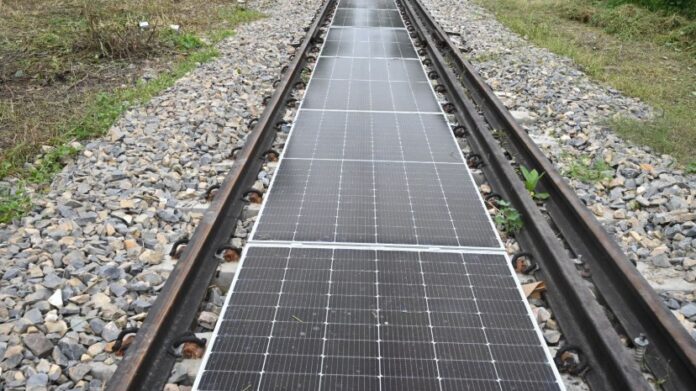In a historic move toward sustainable development, India has launched its first solar-powered railway track, opening an entirely new chapter in the nation’s transport and energy journey. This initiative not only demonstrates the potential of renewable energy in large-scale infrastructure but also highlights India’s growing commitment to reducing its dependency on fossil fuels and moving towards a green future.
A New Dawn for Indian Railways
The Indian Railways, one of the largest rail networks in the world, carries millions of passengers and tons of freight every day. To keep this enormous network running requires a colossal amount of energy, most of which until recently has been sourced from coal and fossil-fuel-based electricity. This dependency has not only been costly but also harmful to the environment due to high carbon emissions.
To address these challenges, Indian Railways has taken a revolutionary step—introducing a solar-powered track system that can generate electricity directly from sunlight. This electricity is then used for train operations, signaling, and other infrastructure, making the system more self-reliant, efficient, and eco-friendly.
How Does the Solar Track Work?
The newly introduced solar-electric track is designed with specially engineered solar panels installed alongside and integrated with the railway lines. These panels capture sunlight and convert it into electricity through photovoltaic cells. The generated power is supplied directly to trains running on the line and to railway signaling systems, ensuring seamless and uninterrupted energy availability.
Unlike conventional setups where solar power is fed into an external grid before distribution, this innovation allows electricity to be used at the source—making it faster, more efficient, and less wasteful. It represents a leap in technological innovation tailored exclusively for railway operations.
Environmental Benefits: A Greener Future on Rails
This initiative is much more than a technological showcase; it is a crucial step in combating climate change. By adopting solar energy for train operations, India significantly reduces its carbon footprint.
- Lower Emissions: Solar energy reduces dependency on coal-based power, cutting greenhouse gas emissions.
- Cleaner Transport: Trains become more sustainable compared to road and air travel.
- Climate Action: Supports India’s international commitments under the Paris Agreement for cleaner energy.
Railways already consume around 2% of the country’s total electricity demand. Replacing even a fraction of this with solar energy could mean a monumental reduction in carbon emissions on a national scale.
Economic Advantages: Cutting Costs and Creating Jobs
Switching to solar power is not just environmentally friendly but also economically prudent. Electricity is one of the biggest expenditures for Indian Railways. By generating its own clean power, the railways can reduce annual energy costs substantially.
Moreover, the expansion of solar infrastructure brings new job opportunities—from manufacturing panels to installation, maintenance, and monitoring. This creates a ripple effect in rural and semi-urban areas where many solar projects are set up, boosting local economies and livelihoods.
A Technological Milestone
The solar-powered track marks a first-of-its-kind engineering breakthrough in India’s transport sector. Unlike conventional solar farms, these tracks are designed to withstand the unique conditions of railways: high vibrations, heavy dust, fluctuating weather, and constant train movement.
- Durability: Panels are built to resist extreme heat, monsoon rains, and dust storms.
- Efficiency: Smart monitoring systems track output in real-time and alert operators to any technical glitches.
- Scalability: The model can be replicated across thousands of kilometers of railway track nationwide.
This blend of renewable energy and railway infrastructure could become a benchmark not just for India but for other developing nations seeking sustainable transport solutions.
Global Context: India Joins the Leaders
Several countries have experimented with integrating renewable energy into railway systems. In parts of Europe, solar farms have been connected to train networks, while Japan has explored hydrogen-powered trains. However, India’s model of a dedicated solar-powered track brings a new dimension—direct generation and utilization at the railway line itself.
International observers are already recognizing this as a game-changing model that could inspire other nations with extensive rail networks to follow suit.
Indian Railways’ Larger Sustainability Vision
This solar initiative is only the beginning of a much larger transformation. Indian Railways has already declared its ambition to become a net zero carbon emitter by 2030. To achieve this, it is exploring multiple renewable energy options:
- Solar Energy: Expanding solar track projects across various regions.
- Wind Power: Harnessing wind farms to generate clean electricity.
- Hydrogen Fuel: Piloting hydrogen-based train technologies for long-haul operations.
- Energy Efficiency: Upgrading locomotives and infrastructure for reduced consumption.
The solar track is thus a stepping stone in a comprehensive plan to make Indian Railways the greenest rail network in the world.
Voices from the Ground
Passengers and environmental activists alike have welcomed this step. Commuters express pride in traveling in trains powered by the sun, while experts hail the project as an example of how infrastructure can evolve sustainably without compromising efficiency.
One passenger described the experience as “traveling into the future while preserving the planet,” while an environmental researcher noted that this initiative proves progress and ecology can coexist.
Challenges Ahead
While the launch of the first solar-powered railway track is a milestone, challenges remain. Large-scale implementation requires huge initial investments, land for solar panel installation, and consistent maintenance. Dust accumulation on panels in certain regions, seasonal variations in sunlight, and grid integration during cloudy days are also hurdles to overcome.
Yet, with India’s proven track record in scaling renewable energy projects—such as its rapid rise in global solar capacity—experts believe these challenges are manageable.
Conclusion: A Symbol of Hope and Innovation
India’s first solar-powered railway track is more than just a technological project—it is a symbol of hope for sustainable progress. At a time when the world is battling the devastating effects of climate change, India has shown how renewable energy can be seamlessly integrated into one of the largest transport systems on earth.
This achievement signals to the world that economic growth and environmental responsibility need not be opposing forces. With the sun as its new driver, Indian Railways is charting a course toward a future where clean energy, innovation, and sustainable mobility define the nation’s journey.








[…] Read More: Rail Powered by the Sun: India’s First Solar-Electric Track Marks a New Era […]